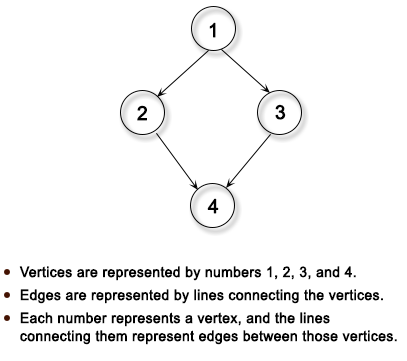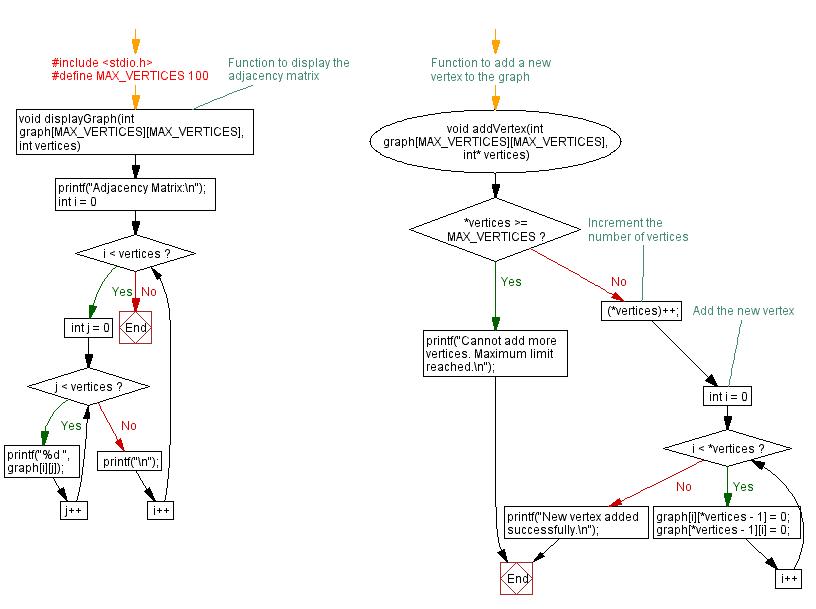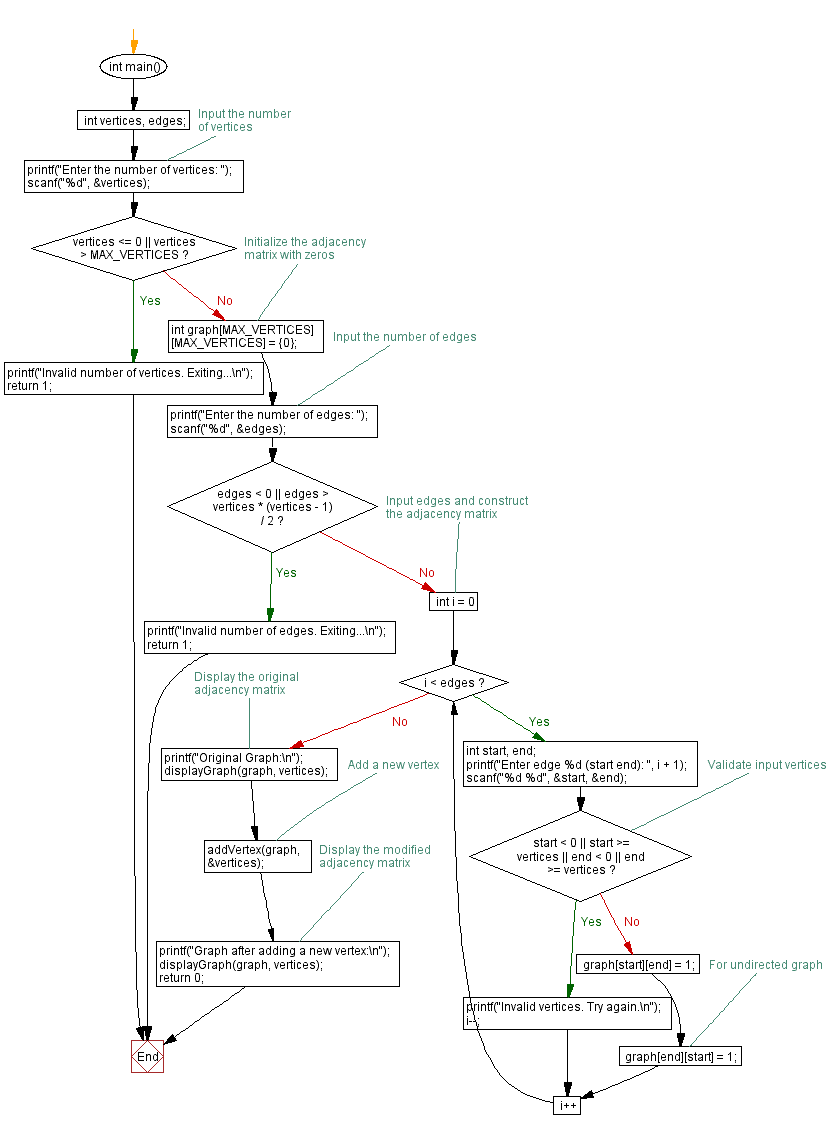Add Vertex to existing Graph: C Program Example
2. Add Vertex to Graph Extended Challenges
Write a C program that implements a function to add a new vertex to an existing graph.

Vertices are represented by numbers 1, 2, 3, and 4.
Edges are represented by lines connecting the vertices.
Sample Solution:
C Code:
#include <stdio.h>
#define MAX_VERTICES 100
// Function to display the adjacency matrix
void displayGraph(int graph[MAX_VERTICES][MAX_VERTICES], int vertices) {
printf("Adjacency Matrix:\n");
for (int i = 0; i < vertices; i++) {
for (int j = 0; j < vertices; j++) {
printf("%d ", graph[i][j]);
}
printf("\n");
}
}
// Function to add a new vertex to the graph
void addVertex(int graph[MAX_VERTICES][MAX_VERTICES], int* vertices) {
if (*vertices >= MAX_VERTICES) {
printf("Cannot add more vertices. Maximum limit reached.\n");
return;
}
// Increment the number of vertices
(*vertices)++;
// Add the new vertex
for (int i = 0; i < *vertices; i++) {
graph[i][*vertices - 1] = 0;
graph[*vertices - 1][i] = 0;
}
printf("New vertex added successfully.\n");
}
int main() {
int vertices, edges;
// Input the number of vertices
printf("Enter the number of vertices: ");
scanf("%d", &vertices);
if (vertices <= 0 || vertices > MAX_VERTICES) {
printf("Invalid number of vertices. Exiting...\n");
return 1;
}
int graph[MAX_VERTICES][MAX_VERTICES] = {0}; // Initialize the adjacency matrix with zeros
// Input the number of edges
printf("Enter the number of edges: ");
scanf("%d", &edges);
if (edges < 0 || edges > vertices * (vertices - 1) / 2) {
printf("Invalid number of edges. Exiting...\n");
return 1;
}
// Input edges and construct the adjacency matrix
for (int i = 0; i < edges; i++) {
int start, end;
printf("Enter edge %d (start end): ", i + 1);
scanf("%d %d", &start, &end);
// Validate input vertices
if (start < 0 || start >= vertices || end < 0 || end >= vertices) {
printf("Invalid vertices. Try again.\n");
i--;
continue;
}
graph[start][end] = 1;
graph[end][start] = 1; // For undirected graph
}
// Display the original adjacency matrix
printf("Original Graph:\n");
displayGraph(graph, vertices);
// Add a new vertex
addVertex(graph, &vertices);
// Display the modified adjacency matrix
printf("Graph after adding a new vertex:\n");
displayGraph(graph, vertices);
return 0;
}
Output:
Enter the number of vertices: 4 Enter the number of edges: 3 Enter edge 1 (start end): 0 1 Enter edge 2 (start end): 1 2 Enter edge 3 (start end): 2 3 Original Graph: Adjacency Matrix: 0 1 0 0 1 0 1 0 0 1 0 1 0 0 1 0 New vertex added successfully. Graph after adding a new vertex: Adjacency Matrix: 0 1 0 0 0 1 0 1 0 0 0 1 0 1 0 0 0 1 0 0 0 0 0 0 0
Explanation:
In the exercise above,
- Display Function (displayGraph):
- Prints the adjacency matrix of the graph.
- Add Vertex Function (addVertex):
- Checks if the maximum limit of vertices (MAX_VERTICES) has been reached.
- Increments the number of vertices (vertices) and adds the new vertex connections to the existing graph.
- Main Function (main):
- Inputs the number of vertices and edges from the user.
- Constructs the initial graph based on user input.
- Displays the original adjacency matrix.
- Calls addVertex to add a new vertex.
- Displays the modified adjacency matrix after adding the new vertex.
Flowchart:


For more Practice: Solve these Related Problems:
- Write a C program to extend an adjacency matrix graph by adding a new vertex and reallocating memory dynamically.
- Write a C program to add a new vertex to an existing graph represented by an adjacency matrix and initialize its connections based on user input.
- Write a C program to implement a function that adds a vertex in a weighted graph and updates the adjacency matrix with default edge values.
- Write a C program to modify an adjacency matrix representation to support vertex deletion and subsequent re-addition with a new label.
Go to:
PREV : Graph Matrix Representation Extended Challenges.
NEXT : Directed Edge Insertion Challenges.
C Programming Code Editor:
Have another way to solve this solution? Contribute your code (and comments) through Disqus.
What is the difficulty level of this exercise?
Test your Programming skills with w3resource's quiz.
